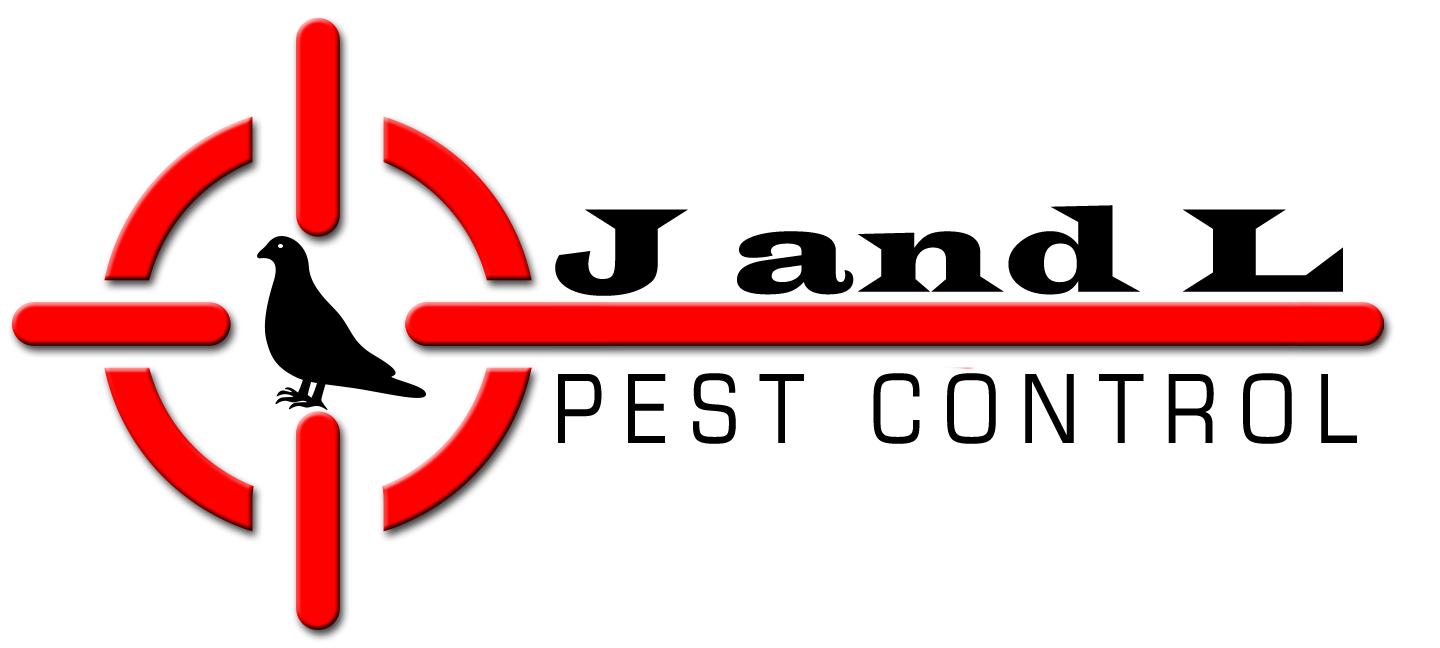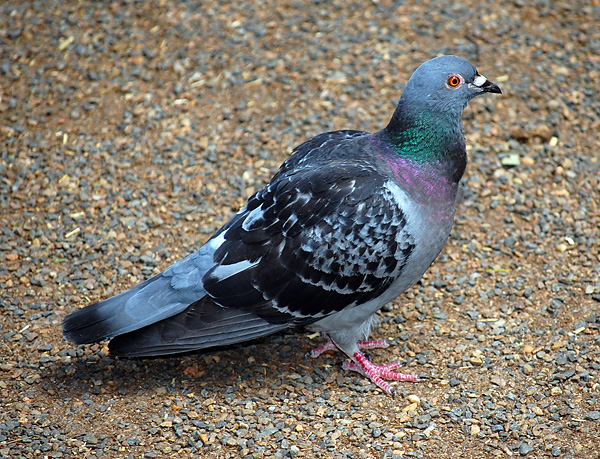
J & L Pest Control is a family owed business that has been practicing Integrated Pest Management (IPM) services since it was founded.
T (631)-605-9919
Email: jandlpestcontrol@gmail.com
J & L Pest Control
1090 Martinstien Ave.
Bay Shore, NY 11706

INTRODUCTION. Pigeons were bred from the European rock dove and introduced as a domestic bird into North America circa 1606. They are now found feral/wild in virtually every city and in most rural areas. Pigeons are of medical concern because more than 50 diseases and ectoparasites have been associated with pigeons, their nests, and droppings. Probably the best known is the lung disease histoplasmosis. They are worldwide in distribution except for the cold northern and southern areas.
RECOGNITION. Adults average about 13" (33 cm) long; average weight about 13 oz (368 g). Stocky/robust, with a short rounded fanlike tail. Color varies from white to black but usually bluish gray with black bands, 2 narrow cross bands on each wing and a broad terminal tail band, white rump, and reddish feet, head dark and often with greenish-purplish iridescence on neck. Each of 2 legs short, bearing 1 rear- projecting and 3 forward-projecting toes. Body and wings covered with feathers and horny bill short, lacking teeth. Voice soft, with guttural series of rolling coos.
SIMILAR GROUPS. (1) Mourning dove (Zenaida (=Zenaidura) macroura) smaller, buff colored, and with long central tail feathers giving pointed appearance to tail. (2) Ringed turtle-dove (Streptopelia risoria) pale tan overall with narrow black collar around back of neck. (3) White-winged dove (Zenaida asiatica) lacks black bands and with large white wing patches conspicuous when in flight.
BIOLOGY. Pigeons are monogamous, pairing for life. About 8-12 days after mating, typically 2 (range 1-2) white eggs are laid per clutch in the nest. Eggs require about 17- 19 days incubation. Hatchlings (squabs) are almost featherless and are totally dependent on the parent birds for warmth and food. For the first 5 days, hatchlings are fed predigested food called “pigeon milk” that is produced in the parent's crop. For the next 5 days, water and grain are added to their milk, and finally they are fed only grain and water. Young pigeons usually make their first flight when about 35-37 days old, but may leave the nest when 4-6 weeks old. Several broods are reared each year with more eggs being laid before the proceeding brood is weaned. Breeding is year round but peaks in the spring and summer. Wild pigeons often live for 15 years and captive pigeons for 30 years or more. In the urban setting, pigeons usually live for 3-4 years.
Pigeons have color vision, a hearing range very close to that of humans, and have poor¬ly developed senses of taste and smell. Although they cannot think, pigeons are capable of conditioned learning.
Pigeons, their nests, and droppings are of medical concern because of the over 50 diseases and ectoparasites associated with them. Diseases include encephalitis (St. Louis, eastern and western equine), histoplasmosis, Newcastle disease, chlamydiosis, and salmonellosis which can affect human and animal health, and severe cases may result in death. The ectoparasites include mites and ticks that often bite humans or infest domestic animals, causing extreme discomfort. Other arthropods, such as dermestid beetles, clothes moths, flies, and stored product pests, associated with the nests and droppings may invade structures.
HABITS. Along with damage and nuisance problems, there are 4 behavioral habits requiring consideration. These are feeding, nesting, roosting, and loafing.
Pigeons prefer to feed on seeds, grain, some fruit, and green feed. However, they will readily feed on garbage, animal matter such as insects and spiders, livestock manure, and many other foods when their preferred food is scarce. Pigeons prefer flat or smooth surfaces, such as roof tops, for feeding. They also consume enough grit to ensure proper digestion. An adult consumes about 1 lb/453 g of food per week. Feeding may occur near the nesting or roosting site(s), but often it is done some distance away.
Nests are loosely constructed and usually consist of sticks, stems, leaves, and other debris. They are built on ledges of structures or cliffs, or in caves. The abundance of clifflike nesting sites, especially on older buildings, is one of the primary factors that attract pigeons to cities. Often nesting and roosting occur in the same general area, but they can be distant.
Roosting sites are where pigeons rest or sleep. They usually involve some kind of perch that is often high off the ground, such as exposed roof girders, protected ledges, etc. Roosting sites may or may not be near nesting, feeding, or loafing areas.
Loafing is loosely defined as when pigeons are not feeding, nesting, or roosting. Loafing may occur almost anywhere pigeons are not constantly disturbed.
Pigeons have very acidic droppings which can deface marble, limestone, painted surfaces, statues, car finishes, etc. Fresh droppings can cause objectionable odors and slippery situations on sidewalks, roads, fire escapes, and other flat surfaces. Droppings, feathers, and nesting materials can contaminate unprocessed grain and packaged foods. Pigeons also have diseases, ectoparasites, and other pests associated with them as mentioned above. Although of minor importance, pigeons can be a problem around airports, especially if there is a garbage dump, railroad siding, or grain field nearby.
CONTROL. Pigeon control or management begins with the most important step, the survey. The survey should address the following: location of problem, species observed (pigeons/nontargets and numbers), habitat (food, water, nesting sites), special equipment, time constraints, analysis of problem, public relations issues, recommended control procedures, and pricing considerations. The site should be visited on several days when typical/normal site activity and weather is occurring. On each day selected, 3 visits should be made (sunrise, midday, and late afternoon), and observations should be record¬ed with date and time. Minimal equipment includes binoculars, bird field identification guide, watch, site plan or map, and reference manual giving biology, habits, and control.
Once the species involved (pigeons and nontargets) are determined via the survey, appropriate federal, state, and local regulations should be checked. Pigeons are not protected by the federal endangered species act or migratory bird statutes, but they are protected by some states; if the area is a bird sanctuary, then local permits are also required.
Many options are available for bird control. There are 5 methods that do not utilize toxicants. The first is exclusion which involves structural modification (e.g. change ledge angle to 45°), the installation of plastic netting, and/or the use of repellents such as plastic and metal spines, monofilament and steel lines, and gels and pastes. The second is sanitation which involves the reduction or elimination of feeding sites and temporary water sources. The third involves the use of sound devices such as noise-making devices (usually not suitable for urban areas). The fourth is trapping which can be effective if the birds are destroyed and not released; otherwise, they will return home or create problems elsewhere. Finally, shooting can also be effective for removing birds within some kinds of buildings.
There is 1 method of control utilizing chemicals or toxicants. This can be considered a chemical frightening agent and involves grain coated with a material that elicits distress symptoms and calls when consumed and results in the remaining portion of the flock being repelled. Its use involves a prebaiting program, and the entire cycle may have to be repeated if other pigeons move in; it may be lethal to glutton pigeons. If nontarget birds are attracted to this treated grain, then the program must be stopped immediately.
